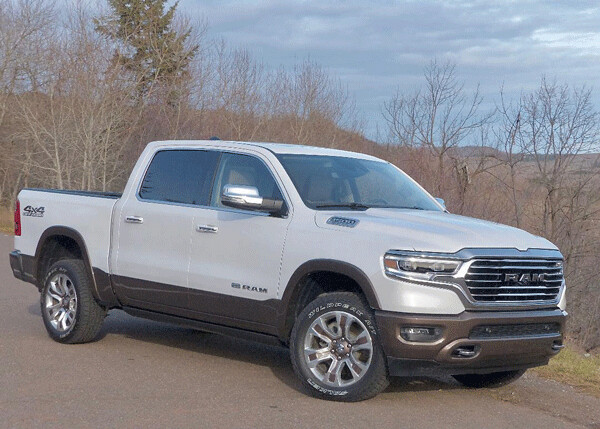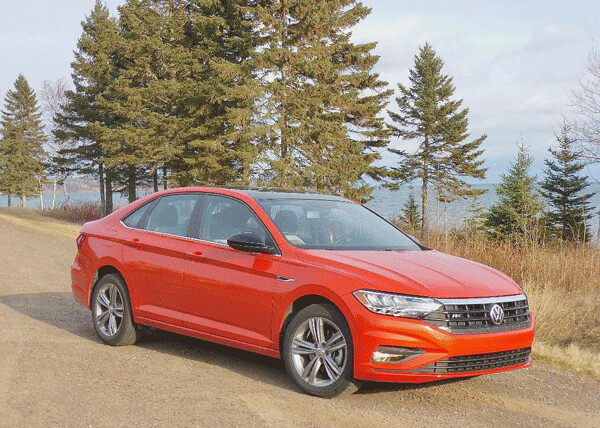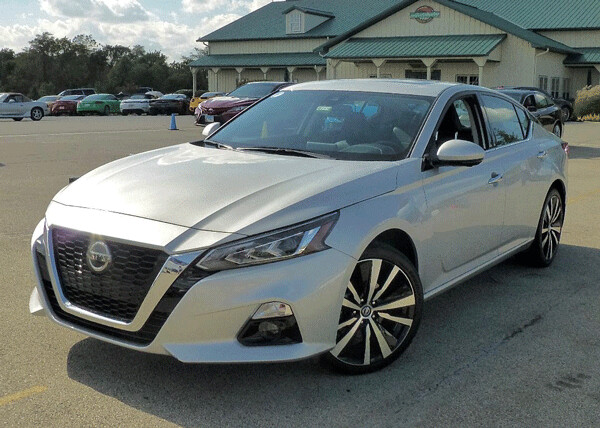Ram Stands as Domestic Favorite to Win Award

The 2019 Ram pickup truck will be carrying the torch for the traditional “Big Three” of U.S. auto makers when it stands alone as the favorite to give domestic procucts a hold on at least part of the new “car of the year” awards.
The Ram has caught up to the traditional favorite top-selling Ford F-150 and Chevrolet Silverado from the standpoints of design, equipment, features, and capability for 2019, and its restyling and particularly its luxury-car-like interior attractions have made it run away with all the awards so far in the auto industry.
The Ram won the Motor Trend Truck of the Year award, and so dominated last month’s annual Texas Truck Rodeo that neither Ford nor General Motors even bothered to enter their cop trucks as competitors.
So when the three finalists line up to be counted for the National Car,Truck and Utility of the Year awards at the January Detroit Auto Show, it is heavily favored to win the strong support of the objective auto media jury and win over the Silverado.
Otherwise, foreign nameplates will attract the most attention as the 2019 models find their way to showrooms around the country and the world. My guess is that the Hyundai Genesis will win Car of the Year, and possibly the Hyundai Kona could win SUV of the Year, to join the Ram as Truck of the Year.
The Kona, a sharply featured all-new compact SUV loaded with technology might be inhibited from winning if the jury members suppress the urge to give the South Korean manufacturer, Hyundai, two of the three awards. For good measure, the redesigned Santa Fe, slightly larger, shares the brilliant Hyundai technolgoy with the Kona of highly efficient engines, plus a lane-departure sysem that keeps your vehicle centered in its lane and will prove invaluable to drivers who might never know how they could have gone off the road or spun out had they not had a vehicle with such virtues. But the Santa Fe is not a finalist for the SUV award at Detroit.

The Genesis is a new stand-alone model from Hyundai, and it is a beautifully designed all-new sedan that bridges the gap between a true German-styled sports sedan and a true German-designed luxury sedan. For about half the money. It comes with a very efficient 4-cylinder base engine, or a pair of fire-breathing turbocharged V6s, both a 3.3 and a 3.8 liter, with all-wheel drive available.
When Motor Trend named the Genesis its Car of the Year in its current edition,its band of writers all remarked about how sporty the rear-drive turbo V6 powertrain worked, even though the vast majority of consumers will go for the more basic but still efficient 4-cylinder, and/or all-wheel drive.

There are numerous other remarkable technical vehicles just coming out. Volkswagen’s new Jetta, for example, packs a lot of equipment into the new vehicle, including a design that looks far more luxurious than a $20,000 vehicle deserves. The interior is also redesigned in an attractively luxurious style, and it comes with a 1.4-liter 4-cylinder that can reach above 30 miles per gallon and even top 40 if you don’t get too deep into the turbocharger too often.

Nissan has also come up with some exceptional powertrain breakthroughs for both its nameplate and its upscale Infiniti line. Not only has it developed its own - and Mercedes’s - dual overhead-cam 4-cylinder turbo 2.0 engine into a high mileage and high power unit, but Nissan introduced its new variable-compression-ratio version of its 2.0-liter turbocharged 4 that has more power than some V8s. Its amazing concept allows drivers to control a range of about 8-to-1 ro 16-to-1 compression on regular gas for enormous power delivery.
On top of that, the midsize Altima should not have escaped the scrutiny of the Car of the Year jury for three reasons. First, it is very well redesigned, second it has one version with the above-mentioned variable compression ratio engine that will get 35-40 miles per gallon and run with any V6 or V8, and third, it can be obtained with all-wheel drive - a first for any mainstream midsize competitor such as Accord or Camry or Mazda6, or Subaru, or Sonata.
Mazda, of course, is about to break out its total redesign of the Mazda3 subcompact, with has beaturiful lines and an all-new SkyActiv engine that puts to use the diesel technology of the piston compressing fuel-air until it explodes without a sparkplug - although it will also have sparkplugs - but it will give the extremely fuel-efficient 13-to-1, regular-gas-burning 2.0-liter 4-cylinder more power and more fuel economy at the same time.
The expanding titles of the various contemporary awards signal what is happening in the auto business. What used to be the North American Car of the Year competition spread to include trucksas a separate entity, which made sense, and a few years ago, the jury board membdoers arbitrarily decided to add a third category for SUV of the year.
Watering down the award certainly diluted the interest in the event, which kicks off the media days prior to the Detroit show, but it also is an attempt to indicate that car buyers prefer trucks and SUVs to cars these days, thanks to lower gas prices that don’t restrain consumers from going for large vehicles that might get under 20 miles per gallon.
But the headlines and spotlight should still be focusing on technology that leads the way in the industry for coming up with new ideas and helping modify those cars that can extract major power and still increase fuel efficiency of the new vehicles. I was among those who made use of the signs just before Christmas that regular gas could be had for as low as $2.11 and $2.14 per gallon. Great!
But it’s not going to make me foolishly think that gasoline will always be that cheap, so I can forget buying veicles that get over-30 miles per gallon. Our 11-year-old Mini Cooper gets 33-35 miles per gallon in city driving, and can top 35 on the highway. And we’re not giving that up. However, the Mini asks for premium fuel, and while I’d rather try midgrade, my wife, Joan, insists on the richer diet.
That leads to another New Year’s Resolution we all should challenge ourselves to: Whenever you see one of those huge signs that tells how inexpensive regular gas is, drive up to the pump and compare that price to the premium nozzle, a few inches to the right. It might indicate that regular is cheap, but don’t assume premium is only 4-5 cents more per gallon. More like 70-80 cents more per gallon! Now, that’s premium.
There is no greater evidence about the changing of the auto scene and what is happening in the industry than the lack of enthusiasm for the 2019 Detroit International Auto Show. It wasn’t long ago that the world’s auto manufacturers were waiting to converge on Detroit’s Cobo Hall and lay out lavish presentations and often after-hours parties for the media who flocked there to see the newest stuff.
The Los Angeles show challenged Detroit for superiority, and even ran on the same week for a few years, but now LA has moved its show to November and is, by far, the opening show for the major U.S. car displays. Detroit stayed in January - never a good time to visit Detroit - then was followed by the Chicago show in February and the New York show in late April.
This year, however, after Los Angeles had more than a dozen introductions of new vehicles, Detroit is left with some less-scintillating possibilities. First, the Ram is secure, but General Motors and Ford are both making major headlines for plans to close numerous production plants and for eliminating vehicles.
I was surprised when Ford announced it would eliminate all cars except the Mustang and Focus to concentrate on SUVs of all sizes, then added the Focus to the lengthy list that also includes the Taurus, Fusion, and Fiesta among those about to end their production.
Then GM announced it was closing numerous plants in North America, and would eliminate the full-size sedans, including the Chevrolet Impala and the Buick LaCrosse, and the compact Cruze which its television ads have so prominently been featured by using “real people” instead of actors, although it failed to disclose how many of those real people were actually company employees disguised as real people.
We also heard that a half-dozen of the world’s major manufacturers are skipping Detroit, with no display and no PR gatherings. And then we heard the news that Detroit Auto Show organizers have decided to abandon their traditional January week and in 2020 will move their show to June. A lot nicer weather, but the show then will become a place to recap all that has been already introduced at Los Angeles, Chicago, New York - to say nothing of Frankfurt, Paris, Geneva, and Tokyo.
But news of the move might be good timing for GM and Ford, whose executives can probably think of other options to attending a show of crazed media types who will ask endless questions about canceled models and closed plants.
Whatever, my group of five auto journalists who have spent more than a decade car-pooling from a nice, new and inexpensive hotel out by the Detroit Metro Airport to the show instead of paying what has now become about $200 for an “auto show” rate downtown, has dispersed. Not one of the five of us is going to attend the Detroit show, and I feel bad about that. And I feel sad aobut missing the last January Detroit show.
But why should we spend our energy to get there and fight for a vantage point at displays where the manufacturers are either absent or reluctant, and where the show itself is pulling the plug?
